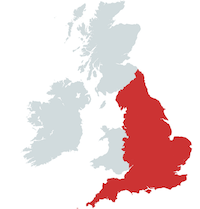
Map by mapchart.net - Some rights reserved.
Location
York, North Yorkshire, England
Description
Clifford's Tower (also known as York Castle) is located in the city of York, England. The remains of a 13th century keep known as Clifford's Tower, and parts of the curtain wall stand on the site. The keep was two stories high with a central stone pillar that supported the first floor. Some traces of the pillar can still be seen. There is a square turret on the south side between two of the lobes that was used to protect the entrance. There are defensive turrets between the other lobes. The walls of the keep still stand, but the roof and internal floor has gone. The keep has an unusual quatrefoil plan (a four-leafed clover shape).
History
The first castle on the site was a wooden motte and bailey castle built in 1068, during the Norman Conquest. The castle be rebuilt in stone in the mid 13th century (between 1245 - 1270) on orders from King Henry III in response to threat from Scottish invasion. A curtain wall with towers and two gateways was built round the bailey, and a stone keep was built on the motte, then known as the King's Tower. The castle was used as the Treasury for King Edward I in 1298 during his campaign against the Scots.
King Edward II also used the castle as a Treasury in his campaign against rebel barons in 1322. After the Battle of Boroughbridge some of the defeated barons were executed at York Castle. By 1358, the stone keep had subsided, causing a large crack to appear in the south east "lobe" of the tower. The keep was in poor condition by the end of the 15th century.
During the English Civil War the Royalists under Henry Clifford, the last Earl of Cumberland, occupied the castle in 1642. Clifford repaired the castle and strengthened the walls. In 1644 anti-Royalist forces including a Scottish army and a Parliamentary force besieged York. Prince Rupert came to negotiate a lifting of the siege, but he was defeated by Parliamentary forces at Marston Moor, six miles west of York. The castle was surrendered to the Parliamentary forces who then slighted the castle. During the reign of Charles II, later in the 17th century, the Castle was partially restored. Henry Clifford, the last Earl of Cumberland, was the last to garrison the castle. It is not clear if the keep became known as Clifford's Tower after Henry Clifford, or after Roger de Clifford, one of the rebels who was hanged there in 1322. The interior of the castle was destroyed in 1684 when an explosion ripped through the artillery store reduced the tower to a shell. The explosion may not have been accidental.
In the 18th century, three new buildings were built south west of Clifford's Tower - the County Gaol, the Assize Courts and the Female Prison. The Assize Courts building is now the York Crown Court. The Female Prison and the County Gaol are now the Castle Museum. In 1825, Clifford's Tower, further new buildings were added and whole castle complex turned into a prison with walls, a gatehouse and extra prison block. The prison was in use from 1835 to 1929, after which the 19th century buildings were demolished. Restoration of the castle began in 1903, and in 1925 was taken over by the Commissioners of His Majesty's Works which later became English Heritage.
The Arts
Clifford's Tower was used as a backdrop in the video for the N-Trance dance hit Set You Free.
Other Castles in the Area
Knaresborough Castle, North Yorkshire
Spofforth Castle, North Yorkshire
|
|
|
|

